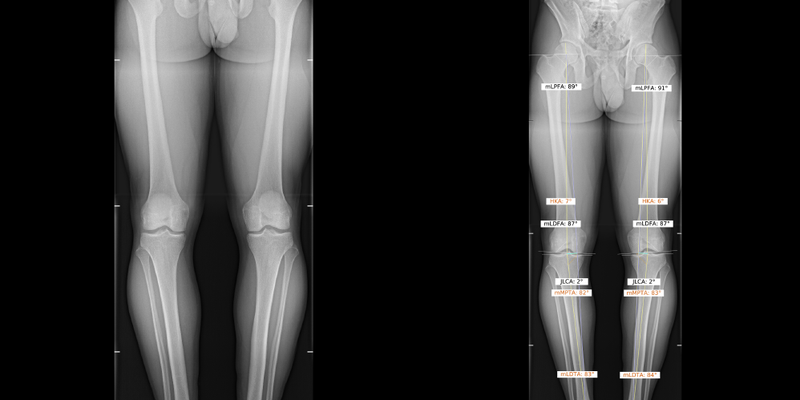
Company: ImageBiopsy Lab Product: IB Lab LAMA
A recent study investigates the efficacy of deep learning algorithms in generating lower extremity radiographic measurements for knee angular alignment and leg length determination. The research involved comparing measurements from an AI software against those of two board-certified radiologists on 164 legs without metal implants.
The primary goal was to evaluate the agreement in leg length discrepancy (LLD) and knee alignment metrics. Results showed that the AI software set incorrect landmarks in only 11 cases. Overall, the AI demonstrated excellent agreement with the radiologists for 12 out of 13 variables, achieving performance targets for most measurements. Notably, the AI significantly reduced reading time, averaging 38.3 seconds compared to 435.0 and 625.0 seconds for the radiologists.
In conclusion, the study highlights that the AI software can reliably generate knee measurements while offering substantial time efficiency, suggesting a promising role for AI in clinical practice.
Deep learning generated lower extremity radiographic measurements are adequate for quick assessment of knee angular alignment and leg length determination
Skeletal Radiology, 2024
Abstract
Purpose
Angular and longitudinal deformities of leg alignment create excessive stresses across joints, leading to pain and impaired function. Multiple measurements are used to assess these deformities on anteroposterior (AP) full-length radiographs. An artificial intelligence (AI) software automatically locates anatomical landmarks on AP full-length radiographs and performs 13 measurements to assess knee angular alignment and leg length. The primary aim of this study was to evaluate the agreements in LLD and knee alignment measurements between an AI software and two board-certified radiologists in patients without metal implants. The secondary aim was to assess time savings achieved by AI.
Methods
The measurements assessed in the study were hip-knee-angle (HKA), anatomical-tibiofemoral angle (aTFA), anatomical-mechanical-axis angle (AMA), joint-line-convergence angle (JLCA), mechanical-lateral-proximal-femur-angle (mLPFA), mechanical-lateral-distal-femur-angle (mLDFA), mechanical-medial-proximal-tibia-angle (mMPTA), mechanical-lateral-distal-tibia- angle (mLDTA), femur length, tibia length, full leg length, leg length discrepancy (LLD), and mechanical axis deviation (MAD). These measurements were performed by two radiologists and the AI software on 164 legs. Intraclass-correlation-coefficients (ICC) and Bland–Altman analyses were used to assess the AI’s performance.
Results
The AI software set incorrect landmarks for 11/164 legs. Excluding these cases, ICCs between the software and radiologists were excellent for 12/13 variables (11/13 with outliers included), and the AI software met performance targets for 11/13 variables (9/13 with outliers included). The mean reading time for the AI algorithm and two readers, respectively, was 38.3, 435.0, and 625.0 s.
Conclusion
This study demonstrated that, with few exceptions, this AI-based software reliably generated measurements for most variables in the study and provided substantial time savings.
Read full study